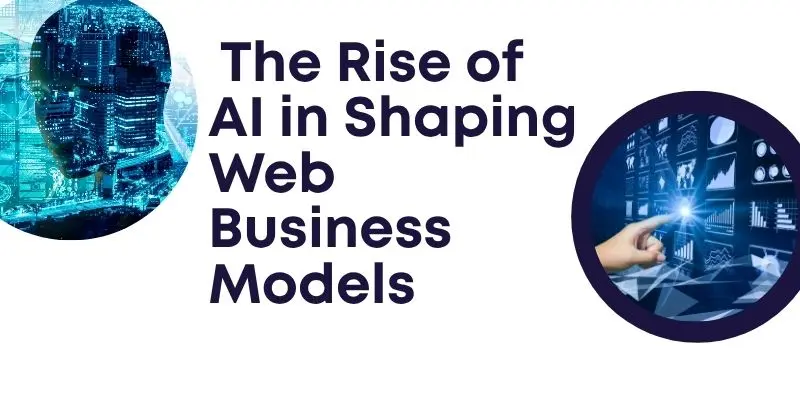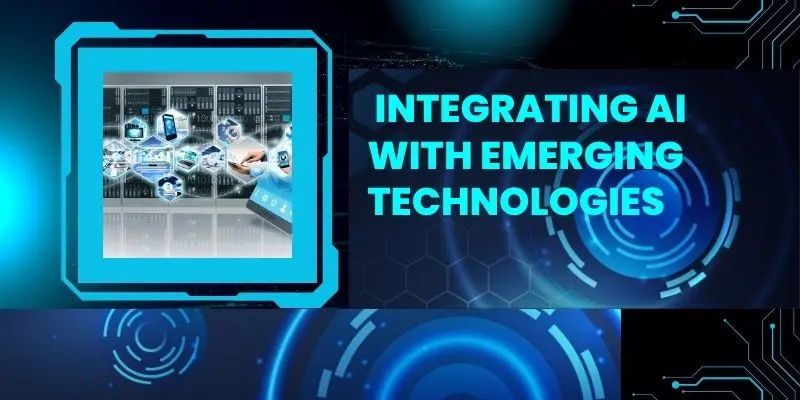How AI is Transforming Web Business Models -What You Need to Know
Published: 02 Jul 2025
Artificial Intelligence isn’t just a buzzword anymore. It’s quietly transforming Web Business Models by changing how online businesses operate, compete, and grow. From smart algorithms to real-time analytics, AI is redefining what’s possible on the web.
In this article, you’ll discover how AI-powered business models work, where they excel, and why they matter. We’ll explore real-world examples, challenges, and the bold future AI promises for digital entrepreneurs.
1. The Rise of AI in Shaping Web Business Models
In the past, most web business models relied on familiar strategies: advertising, subscription fees, or simple e-commerce. But the game is changing fast. Artificial Intelligence (AI) has emerged as a powerful catalyst that is challenging and reinventing how businesses work online.

At its core, AI allows companies to analyze huge volumes of data, predict customer preferences, and automate tasks that once required human oversight. This shift goes beyond adding new features; it transforms the very foundation of how web businesses create value and generate revenue.
Whether it’s streaming platforms suggesting what to watch next, e-commerce sites predicting shopping habits, or digital ads that adapt in real time, AI turns static business models into dynamic, data-driven engines. It creates personalized experiences that keep users engaged and spending longer on platforms.
AI’s influence isn’t limited to big tech. Even small web startups can now tap into AI tools to compete smarter, automate customer service, and refine their offerings. This wave of transformation is forcing every online business to rethink how they deliver value in a digital-first world.
2. What Makes an AI-Powered Business Model Unique?
Traditional web business models were largely static. They relied on predefined strategies, scheduled updates, and broad audience targeting. AI-powered business models, on the other hand, bring a level of adaptability and intelligence that fundamentally changes how digital companies operate and compete.
Data-driven decision-making sits at the heart of these models. AI analyzes vast amounts of user behavior, preferences, and engagement patterns in real time. This means businesses don’t just guess what customers want; they know, often before the customers realize it themselves. Recommendations on streaming platforms, personalized ads on social media, and product suggestions on e-commerce sites are all results of this data-first approach.
Automation is another defining feature. AI automates repetitive and time-consuming tasks: from customer service chatbots to content curation and dynamic pricing adjustments. This reduces costs and frees up human teams to focus on creative, strategic work rather than routine processes.
AI-powered businesses also thrive on innovation loops. Unlike static models that update only when new strategies are manually introduced, AI models constantly learn and evolve. They test different approaches, measure results, and refine strategies, all without waiting for quarterly meetings or manual interventions.
Finally, the shift from static to adaptive strategies makes AI-driven business models truly stand out. Instead of offering the same content, price, or product selection to everyone, AI enables real-time adaptation. For instance, two users visiting the same website might see entirely different recommendations, discounts, or features tailored specifically to them.
This blend of data intelligence, automation, constant learning, and real-time personalization creates a competitive edge that traditional web business models simply can’t match. It turns online platforms into living systems that grow smarter and more effective every day.
3. The Power of Datafication and Algorithm Development
At the heart of every AI-powered web business model lies one powerful principle: datafication. This is the process of transforming everyday user activity clicks, searches, likes, purchases, and even scrolling habits into structured data that AI systems can analyze.

Every digital action a user takes becomes a data point. Over time, these millions of interactions reveal patterns: what people prefer, when they’re most active, what keeps them engaged, and what makes them leave. This raw data forms the backbone of personalization, helping businesses tailor content, ads, and offers to each user’s unique tastes and habits.
But raw data alone isn’t enough. The real magic happens through algorithm development. AI uses sophisticated algorithms, sets of rules, and learning models to process, interpret, and act on this data. These algorithms learn continuously, improving their predictions and recommendations with every new data point they receive.
For example, a music streaming platform might start by recommending popular tracks to a new user. As the user skips some songs and replays others, the AI learns these preferences and adjusts future playlists. Over time, the recommendations become so precise that they feel almost intuitive, boosting user satisfaction and engagement.
Beyond personalization, this process drives efficiency across web businesses. Algorithms can forecast demand to adjust stock levels, detect fraudulent transactions in real time, or dynamically change ad bids to get the best return on investment.
Ultimately, datafication and algorithm development don’t just make digital businesses smarter; they make them responsive and proactive. Instead of waiting for trends to emerge, AI-driven models detect them as they happen, giving companies the power to act instantly and strategically.
It’s this transformation from data to insight to action that fuels the success of modern AI-powered business models on the web.
4. Automation Revolution: From Robotics to Business Processes
When many people think of automation, they imagine robotic arms assembling products on a factory floor. But in the digital era, automating business processes with AI is reshaping modern operations, going far beyond manufacturing and transforming almost every aspect of how web businesses operate.
One of the most visible changes is in digital workflows. AI now handles countless behind-the-scenes tasks that once required manual effort. For example, it can process and tag large volumes of user-generated content, detect spam or harmful posts, and automatically approve legitimate ones. This keeps platforms clean and user-friendly without constant human oversight.
Customer service is another area where AI automation shines. Virtual assistants and chatbots respond instantly to common questions, track orders, reset passwords, and even recommend products. These tools work around the clock, delivering consistent and fast responses that enhance user experience while reducing staffing costs.
Beyond support, AI also automates content delivery. Streaming platforms use algorithms to decide which shows appear on your homepage based on what you’ve watched recently. News websites personalize which stories appear first, adapting in real time to your reading habits. Even email marketing campaigns are now automated, sending messages at the exact moment each subscriber is most likely to open them.
AI-powered business processes go deeper still. Dynamic pricing engines adjust prices in real time based on demand, competitor actions, and inventory levels. E-commerce platforms can automatically reorder products when stock runs low, while AI-driven analytics tools generate reports that help managers make data-backed decisions quickly.
What makes this revolution powerful is not just speed, it’s the ability to adapt and learn. Traditional automation follows fixed rules; modern AI automation uses machine learning to evolve, refine decisions, and get better over time.
In short, AI-driven automation has expanded far beyond physical robots. It now powers digital services, personalized content, and streamlines operations, helping web businesses operate smarter, faster, and more efficiently than ever before.
5. Integrating AI with Emerging Technologies
The power of AI doesn’t work in isolation; it becomes truly transformative when combined with other emerging technologies. Together, they create smarter, faster, and more personalized online services that redefine what users expect from digital platforms.

The Internet of Things (IoT) is a perfect example of this synergy. IoT devices, from smart speakers to wearable fitness trackers, constantly collect data about how users interact with technology and the physical world. AI analyzes this real-time data to personalize web services, recommend content, and even automate everyday tasks. For instance, a user’s smart home device might share temperature preferences with a home automation app, which then uses AI to adjust settings automatically for comfort and energy savings.
Ultra-smart microchips also play a critical role. These chips are designed to process AI algorithms quickly and efficiently, even within small devices. They enable faster data analysis directly on the device itself (known as edge computing) rather than relying solely on remote servers. This means AI-driven services can respond instantly from voice assistants understanding commands faster, to AR apps delivering real-time experiences without lag.
Another transformative technology is AutoML (Automated Machine Learning). Traditionally, building and refining AI models required specialized data scientists and time-consuming manual work. AutoML simplifies this process by automating tasks like selecting algorithms, tuning parameters, and testing models. This allows smaller companies, even those without large AI teams, to build sophisticated AI tools for their websites, apps, and services.
Finally, deep learning brings unmatched power to pattern recognition. These models are the reason why AI can accurately recommend videos, recognize speech, filter spam, or flag harmful content in real time. In web business models, deep learning enables hyper-personalization by analyzing massive and complex datasets to predict what each user might want next.
The integration of AI with these technologies creates a ripple effect across industries: smarter ecommerce recommendations, faster customer support, real-time language translation, and safer browsing experiences. It turns websites and digital services into adaptive, intelligent ecosystems that continuously evolve based on user behavior.
In essence, this synergy isn’t just about adding features; it’s about building truly intelligent online platforms that learn, react, and innovate alongside their users.
6. AI’s Influence Across Industries: Real-World Examples
Artificial Intelligence isn’t just transforming one corner of the digital world; it’s reshaping entire industries, from everyday home devices to complex scientific research. Here’s how AI-powered business models are changing real-world web-based services across different sectors:
Home Security
Modern home security systems have evolved far beyond simple motion detectors. AI-enabled cameras now analyze live video feeds in real time, distinguishing between a pet and an intruder. These systems alert homeowners instantly through apps, often sending short video clips to provide context. Some platforms also learn family routines over time, adjusting sensitivity to reduce false alarms. This blend of AI and web connectivity offers users smarter, more reliable protection and peace of mind.
Weather Forecasting
Weather data has always been complex, but AI makes it actionable. AI models analyze data from satellites, sensors, and historical records to deliver highly localized forecasts. Users can access hyper-personalized weather updates through web apps or smart assistants, which adjust recommendations based on daily routines, for example, warning someone about rain before a planned outdoor workout. Businesses also benefit: delivery companies and event planners use these AI-powered tools to make better, data-driven decisions.
Pharmaceuticals
The pharmaceutical industry traditionally relied on years of lab work and clinical trials to develop new drugs. Today, AI accelerates this process by predicting molecular structures that might work against specific diseases. Web-based AI tools also help researchers scan thousands of medical papers in seconds to identify patterns and potential breakthroughs. Beyond research, AI chatbots guide patients through medication schedules, track side effects, and answer health questions online, improving patient engagement and adherence.
E-commerce and Retail
In online retail, AI goes far beyond recommending products. It powers dynamic pricing, predicts which items will trend next season, and helps manage stock levels by forecasting demand. AI chatbots provide instant support, while visual search tools allow users to upload photos and find similar products within seconds. This level of intelligence keeps users engaged and encourages them to shop more often.
Media and Entertainment
Streaming platforms like Netflix and Spotify use AI to create personalized playlists and content suggestions based on users’ listening or viewing history. News websites adapt front pages in real time, prioritizing articles that match each reader’s interests. This keeps audiences engaged longer and makes advertising more effective.
Finance and Banking
AI algorithms detect unusual transactions in real time, reducing fraud. Personal finance apps use AI to categorize expenses, forecast cash flow, and suggest saving strategies. Even investment platforms deploy AI-driven models to analyze market trends and recommend portfolios tailored to individual risk preferences.
These real-world examples show that AI isn’t limited to tech giants. Whether it’s protecting homes, improving healthcare, or making shopping more personalized, AI-powered web business models bring smarter, faster, and more user-focused services to every industry. It’s a revolution that touches daily life often in ways users barely notice, but quickly come to rely on.
7. Enhancing Customer Experience Through Instant Analytics
One of the most powerful advantages of AI in web business models is its ability to turn real-time data into meaningful action almost instantly. This capability is transforming how businesses understand and serve their customers, creating smoother, smarter, and more engaging digital experiences.

Real-time data analysis allows businesses to move beyond static dashboards and outdated reports. AI tools monitor user actions on websites and apps as they happen: what pages visitors click, how long they stay, what they ignore, and where they drop off. Instead of waiting for weekly reports, companies can identify and fix issues on the spot, like adjusting a confusing checkout process or reordering homepage content to highlight trending products.
This immediacy translates directly into a better user experience. For example, e-commerce sites can adjust product recommendations during a browsing session, keeping shoppers engaged with items they’re more likely to buy. Streaming platforms can update watchlists in real time based on the most recent viewing habits, while news sites can prioritize articles that match a user’s current interests and behavior.
Beyond personalization, AI-powered instant analytics also help businesses anticipate customer needs before users even voice them. Suppose a customer frequently searches for running shoes but doesn’t make a purchase. AI can spot this pattern and trigger a limited-time discount or send an email highlighting new arrivals in that category. This proactive approach turns hesitant browsers into buyers by removing friction and showing the right offer at the perfect moment.
In customer service, AI chatbots monitor the tone and context of user messages in real time. If frustration is detected, the chatbot can quickly escalate the conversation to a human agent, preventing dissatisfaction and improving service quality.
For content creators and media platforms, instant analytics reveal what types of posts, videos, or topics resonate most at any given moment. Teams can use these insights to create timely content, capitalize on trending topics, and keep audiences engaged.
What makes AI-driven analytics unique is that the learning never stops. Every interaction adds to the system’s understanding, creating a feedback loop that refines recommendations, offers, and service quality over time. Users experience platforms that feel responsive, personalized, and surprisingly intuitive as if the website “knows” them.
In a competitive digital landscape, this blend of speed, intelligence, and adaptability isn’t just an advantage; it’s quickly becoming an expectation. Businesses that harness instant analytics stay one step ahead, meeting customer needs before they’re even expressed and setting a new standard for user experience online.
8. Data Privacy, Security Challenges, and Ethical Dilemmas
While AI brings powerful benefits to web business models, it also introduces complex challenges, particularly around data privacy, security, and ethics. As businesses become more data-driven, the stakes for handling that data responsibly grow higher than ever.
Data misuse and over-collection are major risks. AI relies on vast amounts of user data to deliver personalized services and real-time recommendations. But gathering too much data or collecting it without clear consent can violate user trust and even break privacy laws. For instance, tracking detailed browsing behavior, location data, and personal preferences can feel intrusive if users don’t fully understand what’s being collected and why.
Security breaches are another critical concern. Storing large volumes of personal data creates attractive targets for cybercriminals. Even the most advanced AI systems are vulnerable if they’re built on insecure infrastructure or outdated security practices. A single breach can expose sensitive information, damage a brand’s reputation, and lead to legal penalties.
Beyond privacy and security, AI-powered models face ethical dilemmas that aren’t always easy to solve. For example, algorithms trained on biased data can unintentionally reinforce stereotypes, such as offering different pricing or content based on demographics. Similarly, over-reliance on automated systems may remove human judgment from decisions that affect real people, like credit approvals or job recommendations.
There’s also the question of transparency. AI systems can be so complex that even their creators can’t always fully explain how specific decisions are made. This “black box” effect can erode trust if users feel they’re being judged by invisible and unaccountable algorithms.
To address these challenges, companies must invest in responsible AI design. This includes implementing strong encryption and cybersecurity measures, adopting transparent data practices, and regularly auditing AI systems to identify and reduce bias. Clear user consent processes explaining what data is collected, how it’s used, and what choices users have are equally important.
Many experts also recommend a human-in-the-loop approach, where AI handles routine tasks but humans oversee final decisions in sensitive areas. This balance ensures AI enhances human judgment instead of replacing it entirely.
Ultimately, the promise of AI in web business models is enormous, but so are the responsibilities. Building user trust requires businesses to prioritize privacy, security, and ethics from day one. By doing so, they not only comply with regulations but also create digital experiences that users can trust and embrace.
9. Is AI Threatening the Traditional Web Economy?
As AI reshapes web business models, it’s sparking a growing debate: could this very transformation endanger the foundations that have sustained the free and open web for decades?
One of the loudest voices in this conversation is Matthew Prince, CEO of Cloudflare, who argues that AI is “killing the business model of the web.” His concern, echoed by many industry insiders, centers on how AI disrupts the value exchange between platforms and content creators. Traditionally, this exchange has been straightforward: creators produce articles, videos, or tools; platforms distribute them and monetize the audience’s attention through ads or subscriptions; and users get access to (mostly) free content.
But AI changes the equation. Advanced language models and generative tools can summarize, remix, or even replicate original content, sometimes without clear attribution or compensation to creators. For instance, a user might ask an AI chatbot for a summary of a news article instead of clicking through to the publisher’s website. This keeps users within AI-powered tools and away from the sources that depend on ad revenue or paywalls to survive.
Ad revenue, long the lifeblood of free web content, is also under pressure. If users spend more time interacting directly with AI interfaces rather than browsing websites, fewer ads are seen, reducing income for publishers and independent creators alike. The challenge is particularly sharp for smaller sites and niche blogs that rely on every click to stay afloat.
Beyond revenue, there’s the issue of creator incentives. If AI-generated summaries, answers, or media pull attention away from original creators, why would those creators continue investing time and resources into producing quality content? This could lead to a digital environment flooded with recycled or AI-generated material, eroding the depth and diversity that made the web vibrant in the first place.
Critics also highlight the risk of platform dominance. AI capabilities are often concentrated in the hands of a few large tech companies that can afford the massive data and computing power needed. This may deepen existing inequalities, making it harder for smaller players to compete and innovate.
However, some see opportunity rather than threat. Proponents argue that AI can help creators by improving productivity, automating editing, and uncovering new audience insights. For instance, AI tools can help creators write faster, suggest headlines with better engagement potential, or analyze which topics resonate most.
Ultimately, the debate is complex. AI undeniably challenges old business models but also opens the door to new ones, such as personalized content subscriptions, AI-assisted creative tools, or licensing deals for data used to train AI models.
What’s clear is that the rise of AI forces the web economy to evolve. Finding a balance where creators are fairly compensated, content remains accessible, and innovation continues will be one of the defining challenges of the next digital decade.
10. The Future of AI in Web Business Models: Trends and Opportunities
As AI continues to transform the digital landscape, the next chapter promises even bigger shifts, bringing new tools, smarter technologies, and business models that redefine what’s possible online. Let’s explore some of the most important trends and opportunities shaping the future of AI in web business models.
Deep learning is a must-have skill
Deep learning, a specialized area of AI, powers everything from voice assistants to advanced recommendation engines. As businesses compete to deliver hyper-personalized experiences, understanding deep learning won’t just be for AI specialists —marketers, product managers, and entrepreneurs will also need to grasp its basics to build smarter strategies and stay competitive.
Smarter, ultra-efficient chips
Hardware innovations are making AI faster and more energy-efficient. New generations of ultra-smart microchips can process complex AI tasks directly on devices (edge computing). This means web platforms and apps can deliver real-time personalization, image recognition, and language processing without waiting for cloud servers, boosting speed, privacy, and user satisfaction.
Emergence of new AI-powered service models
AI isn’t just improving existing web businesses; it’s creating entirely new ones. For example, AI-as-a-Service platforms allow even small startups to integrate powerful machine learning features into their apps without needing in-house AI teams. Generative AI tools let creators produce graphics, text, and videos in seconds, giving rise to new creative services. Similarly, dynamic pricing engines, AI-driven fraud detection, and predictive analytics are becoming standalone services that other businesses can adopt.
Unlocking fresh revenue streams
AI opens doors to monetizing data in innovative ways. Businesses can sell anonymized user behavior insights, build premium AI-driven personalization tools, or offer subscription services based on advanced analytics. For instance, an e-commerce platform could offer merchants AI-powered dashboards to predict trends, while media platforms could let advertisers target audiences with unprecedented precision.
Better integration with emerging technologies
AI’s future impact will multiply when combined with technologies like augmented reality (AR), virtual reality (VR), and blockchain. Imagine online stores using AI to create personalized virtual showrooms or social media platforms that use real-time deep learning to moderate live AR content safely and responsibly.
Greater focus on ethical and responsible AI
With great power comes great responsibility. As AI’s influence deepens, businesses will need to prioritize transparency, fairness, and accountability. Future web business models will likely include clearer data consent tools, explainable AI features, and human oversight mechanisms to ensure trust.
AI democratization
One of the most promising trends is making advanced AI tools accessible to everyone, from small business owners to solo creators. Platforms that offer drag-and-drop AI tools, low-code machine learning, and intuitive dashboards will empower more people to launch innovative services and compete on a global scale.
In summary, the future of AI in web business models is more than just faster algorithms or bigger datasets. It’s about transforming ideas into adaptive, intelligent, and ethical digital experiences, opening the door to new industries, empowering creators, and reshaping how value is created and shared online. The most exciting part? We’re only at the beginning.
Conclusion
Artificial Intelligence isn’t just an add-on for today’s web businesses; it’s at the heart of a new digital revolution. From data-driven decision-making and real-time personalization to automation and emerging technologies, AI is reshaping how value is created, delivered, and sustained online. Yet this transformation comes with real challenges: data privacy concerns, ethical dilemmas, and the disruption of traditional revenue models that have long supported free web content.
The future of AI in web business models isn’t set in stone; it’s being written daily by innovators, creators, and users alike. Businesses that embrace AI responsibly, blending its power with transparency and human insight, stand to unlock new opportunities, delight customers, and stay ahead in an ever-evolving digital world. As AI continues to advance, one thing is clear: the web’s next chapter will be smarter, faster, and more adaptive than ever before.
FAQs
AI business models often revolve around data-driven personalization, automation, AI-as-a-Service platforms, and predictive analytics that create new revenue streams.
You can integrate AI for chatbots, content recommendations, dynamic pricing, real-time analytics, and personalized user experiences through APIs or AI development tools.
The most common are machine learning, deep learning, natural language processing (NLP), and computer vision, each suited to different business needs.
AI enables new models by automating tasks, uncovering patterns in user data, and delivering personalized services that increase engagement and profit.
Costs vary, but cloud-based AI tools and AI-as-a-Service make it accessible even for small websites without large budgets.
Not entirely, while AI can automate many processes, human oversight remains essential for complex, ethical, and creative decisions.
E-commerce, media, finance, health, and education see major gains from personalization, predictive analytics, and automation.
Yes, AI systems rely on large datasets, so responsible design, encryption, and clear consent practices are vital to protect user privacy.
Possibly, AI-generated summaries and direct answers can keep users away from original sites, reducing ad views and changing traffic patterns.
Expect deeper personalization, real-time adaptation, and the emergence of new AI-powered services, alongside a growing focus on ethics and transparency. Artificial Intelligence isn’t just a buzzword anymore. It’s quietly transforming how online businesses operate, compete, and grow. From smart algorithms to real-time analytics, AI is redefining what’s possible on the web.

- Be Respectful
- Stay Relevant
- Stay Positive
- True Feedback
- Encourage Discussion
- Avoid Spamming
- No Fake News
- Don't Copy-Paste
- No Personal Attacks

- Be Respectful
- Stay Relevant
- Stay Positive
- True Feedback
- Encourage Discussion
- Avoid Spamming
- No Fake News
- Don't Copy-Paste
- No Personal Attacks





